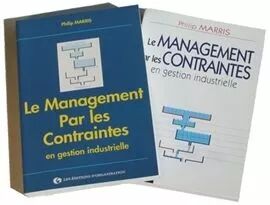Theory of Constraints, Critical Chain Project Management, Lean : industry consulting & training - Marris Consulting
Production: 6 signs that indicate that you should consider better managing your constraints
Production: 6 signs that indicate that you should consider Constraints Management
Here is a brief list of six symptoms that suggest you should invest in better management of your constraints. If you recognize your company's situation in at least one of these statements you really should consider Constraints Management.
1. You could sell more if only ...
2. You cannot invest in additional resources
3. You have too much inventory but never what is needed
4. You have shortages and part hunters
5. You are not able to deliver consistently on time
6. You are not sure whether your organization is V, A or T

Let’s see in greater detail if these situations apply to your business.
1. You could sell more if only...
...you had more products available! Demand exceeds your capacity and it is heart-breaking not to be able to serve customers.
Even more if you see them turning to your competitors!
Before knowing about Constraints Management, most managers are wasting the limited capacity of their most valuable resources.
Using Constraints Management it is common to recover over 20% of previously wasted capacity without investing in extra resources or subcontracting.
But perhaps you are operating in a saturated and highly competitive market?
Selling more is then only possible by stealing market share from your competitors.
Since all competitors have access to more or less the same technologies, similar machines and similar resources, what makes the difference is the proper exploitation of these resources.
Here again Constraints Management helps developing difficult to imitate competitive advantages and thereby increase one's market share.
2. You cannot invest in additional resources
In most cases it is not necessary to invest (immediately) in additional resources, we must properly exploit the current available capacity first.
Yet only a small number your resources determine the throughput and overall performance of your organization. Practitioners talk about the law of "1% / 99%" to describe the tremendous leverage effect on focusing on the very few critical resources.
It is precisely on these extremely valuable and critical resources that Constraint Management focuses on.
3. You have too many inventories but never what it takes
Ignoring the virtuous rules of Constraints Management leads to overproduction because the common way of thinking strives to "ensure productivity". Yet keeping non-critical resources busy for the sake of productivity leads to an increase of inventories and WIP.
Therefore companies have huge inventories (i.e. frozen cash), but never what is needed.
Constraints' management activates non-critical resources only when necessary, synchronizing them to the pace of the bottleneck, thus drastically decreasing inventories and WIP.
4. You have shortages and part hunters
Part hunters are the consequence from the above mentioned causes and one of the visible symptoms.
From a Lean point of view, part hunters are a waste on top of another waste (unnecessary inventories) because they do not solve any of the problems leading to lost parts.
5. You are not able to deliver consistently on time
The lead time of a process is directly proportional to the inventory levels according to Little's law.
The more inventories you have, the longer the lead time.
Furthermore, unexpected events, breakdowns and problems will also contribute to extend lead times, jeopardizing on-time deliveries.
Constraints Management allows one to meet deadlines with great confidence. The process, cleared from unnecessary inventories and WIP, will flow gently and become "readable".
Any problem that might jeopardize the due dates can be immediately detected and solved.
6. You do not know if your company is of a V, A or T type
Any organization can be described with the generic models known as V, A and T, or a combination of these types.
These letters represent the shape of the flow which, in the V case, usually starts with a few different raw materials and finishes with a large variety of end products. Organizations shaped as an A begin with a large amount of parts and sub-assemblies that converge to assemble a single end product. T plants start with a common stream that later spreads into a wide range of variants, usually customized goods.
Each V, A and T model has generic problems identified in the Constraints Management body of knowledge as well as proven and effective solutions. Knowing the type of plant can therefore be really helpful to quickly improve the situation.
For more information about Constraints Management:
The Constraints Management website

About Marris Consulting
Marris Consulting is an industry consulting and training company specialized in the Theory of Constraints (ToC) and Critical Chain Project Management. We focus on improving the performance of manufacturing and process industries by using Constraints Management combined with Lean and Six Sigma. To boost project performance, we also use Critical Chain Project Management (CCPM), which we sometimes combine with Lean Engineering. Our 2-day performance audits, our performance consulting services and our project management, Lean, ToC & CCPM training by our industry consultants offer a wide range of solutions to help our clients around the world reach the highest possible levels of performance.


